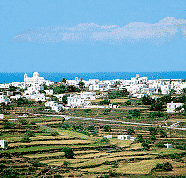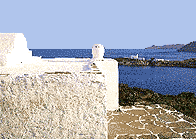Grey trails line the rocks of Sifnos and white chapels lie between them. Here green alternates with dazzling white. Rare beauty, spellbinding views. Yards, alleyways, workshops, where the famous Sifnian pottery is made 365 churches, chapels and important monasteries. Island of the Cyclades group, consisting of a limestone ridge whose principal peaks, Profitis Ilias (694 m) and Agios Simeon (495 m), are crowned by Byzantine churches; the island is 73 square km in area.
According to mythology, Sifnos took its name from Sifnos, son of the Attican hero Sounios. Carians, Phoenicians, and Asians are believed to have first settled the island. However, due to the lack of proof on the subject, the prevailing theory is that the island was first inhabited by the Aegeans, who belonged to the Mediterranean race and the Cretans who joined them. During the Peloponnesian Wars, the island took the part of the Athenians and, after its end, joined the Athenian League. Later, it passed to the Macedonians, Ptolemies, and Romans. The latter used it as an exile. Pirate raids ravaged the island during Byzantine times when it was subject to the Theme of the Aegean. In 1207, it was captured by the Turks, who kept it until the early 19th century, with an interval of four years of Russian occupation. During the Greek War of Independence of 1821, Sifnians took an active part and were liberated in 1830, together with the rest of the Cycladians. The island's history continued its bloody course up until the Balkan wars and the two world wars. The island was famous since the ancient times for its gold and silver mines and quarries of Sifnos stone, enjoying a great prosperity as we can see from it's Treasuries at Delfi, that were dedicated to the god Apollo. "Apollonia" the island's capital is built on three hills with typical Cycladic style, with walls, terraces, countryards and narrow streets, arranged harmonically in the natural environment. A large collection of Archaic and Hellenistic sculpture and pottery from the Geometric to the Byzantine periods, is on display at the island's Archaeological museum. Beautiful, clean and well known beaches of the island are "Kamares", "Faros" and "Platis Yialos". In antiquity Siphnus was colonized by Athens. Its gold and silver mines financed a treasury at Delphi in about 525 BC, but by the 1st century AD they were flooded. A refuge from iconoclastic persecutions at Byzantium during the early Christian era, the island has many Byzantine and post-Byzantine churches and monasteries, some in ruins.Those that are still in the island today are:
However, due to the lack of proof on the subject, the prevailing theory is that the island was first inhabited by the Aegeans, who belonged to the Mediterranean race and the Cretans who joined them. During the Peloponnesian Wars, the island took the part of the Athenians and, after its end, joined the Athenian League. Later, it passed to the Macedonians, Ptolemies, and Romans. The latter used it as an exile. Pirate raids ravaged the island during Byzantine times when it was subject to the Theme of the Aegean. In 1207, it was captured by the Turks, who kept it until the early 19th century, with an interval of four years of Russian occupation. During the Greek War of Independence of 1821, Sifnians took an active part and were liberated in 1830, together with the rest of the Cycladians. The island's history continued its bloody course up until the Balkan wars and the two world wars. The island was famous since the ancient times for its gold and silver mines and quarries of Sifnos stone, enjoying a great prosperity as we can see from it's Treasuries at Delfi, that were dedicated to the god Apollo. "Apollonia" the island's capital is built on three hills with typical Cycladic style, with walls, terraces, countryards and narrow streets, arranged harmonically in the natural environment. A large collection of Archaic and Hellenistic sculpture and pottery from the Geometric to the Byzantine periods, is on display at the island's Archaeological museum. Beautiful, clean and well known beaches of the island are "Kamares", "Faros" and "Platis Yialos". In antiquity Siphnus was colonized by Athens. Its gold and silver mines financed a treasury at Delphi in about 525 BC, but by the 1st century AD they were flooded. A refuge from iconoclastic persecutions at Byzantium during the early Christian era, the island has many Byzantine and post-Byzantine churches and monasteries, some in ruins.Those that are still in the island today are:
According to mythology, Sifnos took its name from Sifnos, son of the Attican hero Sounios. Carians, Phoenicians, and Asians are believed to have first settled the island.
 However, due to the lack of proof on the subject, the prevailing theory is that the island was first inhabited by the Aegeans, who belonged to the Mediterranean race and the Cretans who joined them. During the Peloponnesian Wars, the island took the part of the Athenians and, after its end, joined the Athenian League. Later, it passed to the Macedonians, Ptolemies, and Romans. The latter used it as an exile. Pirate raids ravaged the island during Byzantine times when it was subject to the Theme of the Aegean. In 1207, it was captured by the Turks, who kept it until the early 19th century, with an interval of four years of Russian occupation. During the Greek War of Independence of 1821, Sifnians took an active part and were liberated in 1830, together with the rest of the Cycladians. The island's history continued its bloody course up until the Balkan wars and the two world wars. The island was famous since the ancient times for its gold and silver mines and quarries of Sifnos stone, enjoying a great prosperity as we can see from it's Treasuries at Delfi, that were dedicated to the god Apollo. "Apollonia" the island's capital is built on three hills with typical Cycladic style, with walls, terraces, countryards and narrow streets, arranged harmonically in the natural environment. A large collection of Archaic and Hellenistic sculpture and pottery from the Geometric to the Byzantine periods, is on display at the island's Archaeological museum. Beautiful, clean and well known beaches of the island are "Kamares", "Faros" and "Platis Yialos". In antiquity Siphnus was colonized by Athens. Its gold and silver mines financed a treasury at Delphi in about 525 BC, but by the 1st century AD they were flooded. A refuge from iconoclastic persecutions at Byzantium during the early Christian era, the island has many Byzantine and post-Byzantine churches and monasteries, some in ruins.Those that are still in the island today are:
However, due to the lack of proof on the subject, the prevailing theory is that the island was first inhabited by the Aegeans, who belonged to the Mediterranean race and the Cretans who joined them. During the Peloponnesian Wars, the island took the part of the Athenians and, after its end, joined the Athenian League. Later, it passed to the Macedonians, Ptolemies, and Romans. The latter used it as an exile. Pirate raids ravaged the island during Byzantine times when it was subject to the Theme of the Aegean. In 1207, it was captured by the Turks, who kept it until the early 19th century, with an interval of four years of Russian occupation. During the Greek War of Independence of 1821, Sifnians took an active part and were liberated in 1830, together with the rest of the Cycladians. The island's history continued its bloody course up until the Balkan wars and the two world wars. The island was famous since the ancient times for its gold and silver mines and quarries of Sifnos stone, enjoying a great prosperity as we can see from it's Treasuries at Delfi, that were dedicated to the god Apollo. "Apollonia" the island's capital is built on three hills with typical Cycladic style, with walls, terraces, countryards and narrow streets, arranged harmonically in the natural environment. A large collection of Archaic and Hellenistic sculpture and pottery from the Geometric to the Byzantine periods, is on display at the island's Archaeological museum. Beautiful, clean and well known beaches of the island are "Kamares", "Faros" and "Platis Yialos". In antiquity Siphnus was colonized by Athens. Its gold and silver mines financed a treasury at Delphi in about 525 BC, but by the 1st century AD they were flooded. A refuge from iconoclastic persecutions at Byzantium during the early Christian era, the island has many Byzantine and post-Byzantine churches and monasteries, some in ruins.Those that are still in the island today are:The church of Panagia Geranioforou is situated in Apollonia. It is built on the site of a previous church, and it is the most beautiful temple on the island. Outside, one can admire the impressive bell-tower, while inside the golden icon stand and the beautiful icons are priceless. On the lintels, the beautiful representations of St George and the Virgin Mary date back to 1767.
Outside, one can admire the impressive bell-tower, while inside the golden icon stand and the beautiful icons are priceless. On the lintels, the beautiful representations of St George and the Virgin Mary date back to 1767.
The celebrated monastery of the island's patron saint "Panagia Hrissopigi" (Our Lady of the Golden Spring) stands at the south-eastern end of the island. It was built in 1650 in a lovely area on the site of an older church. The icon of Zoodohos Pigi is mentioned in a great many legends which allege that it came from the sea. Inside the monastery, there are cells which serve as guest houses. According to an inscription, the great Greek poet Aristomenis Provelegios stayed in one of them.
 Outside, one can admire the impressive bell-tower, while inside the golden icon stand and the beautiful icons are priceless. On the lintels, the beautiful representations of St George and the Virgin Mary date back to 1767.
Outside, one can admire the impressive bell-tower, while inside the golden icon stand and the beautiful icons are priceless. On the lintels, the beautiful representations of St George and the Virgin Mary date back to 1767.The celebrated monastery of the island's patron saint "Panagia Hrissopigi" (Our Lady of the Golden Spring) stands at the south-eastern end of the island. It was built in 1650 in a lovely area on the site of an older church. The icon of Zoodohos Pigi is mentioned in a great many legends which allege that it came from the sea. Inside the monastery, there are cells which serve as guest houses. According to an inscription, the great Greek poet Aristomenis Provelegios stayed in one of them.
The Monastery of Panagia tis Vrissis, or Lady Vrissiani, is situated at a settlement called Exabela a little further along Apollonia. It was built in the 17th century on a site where the old chapel of Agios Antonios existed earlier, and for a long period of time, it has been declared property belonging to the Patriarchate of Constantinople. In the interior of its katholikon (lodger), a remarkable wood-carved screen is preserved, as well as old icons, beautiful frescoes and a small collection of rare manuscripts and ecclesiastical gems. On September 8th, the Monastery's feast-day, a huge festival takes place which attracts a lot of pilgrims from all over Milos. Part of the Venetian duchy of Naxos after 1207, it was recovered by the Byzantines in the 1270s and then ruled by Venetian families from 1307 to 1617, after which the Turks held sway. The main town, Apollonia, lies just southeast of the west-coast port of Kamares. On the east coast, the village of Kastro is on the site of the ancient capital. Chief industries are pottery making and fishing.

